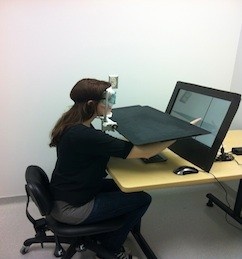Prism Adaptation
Visuo-spatial Neglect:
Right hemisphere brain damage is often associated with an attention disorder called "visuo-spatial neglect." Neglect is a problem with attending, orienting or responding to information on the left side of the body or the left side of the world. Patients with neglect often bump into obstacles on the left, leave food on the left side of their plate and forget to dress or clean the left side of their body. There is no standard treatment for neglect and our Prism Adaptation (PA) studies are focused on developing this technique to treat neglect.
How does Prism Adaptation work?
We use goggles fitted with wedge prisms that shift the visual world to the right. Individuals adapt to these goggles by pointing to targets on a computer screen, and over time, the brain learns to adjust to the deviated world. Once the goggles are removed, the after-effects from the adaptation training shift the visual field in the opposite direction, thus improving performance on the left. Thus, these prisms can help individuals with neglect pay more attention to the left, but the results are often inconsistent between individuals and between tests. Current PA studies thus are tring to identify factors than improve the PA effects.
Current Prism Adaptation studies are investigating the following questions:
- Does the type of target during adaptation change the strength and duration of the aftereffects?
- Does using a game-like "Peg-the-Mole" game for pointing practice also work?
- Do the number or position of targets during adaptation affect the after-effects?
- Can we identify neurophysiological events (ERPs) that are important for Prism adaptation?

